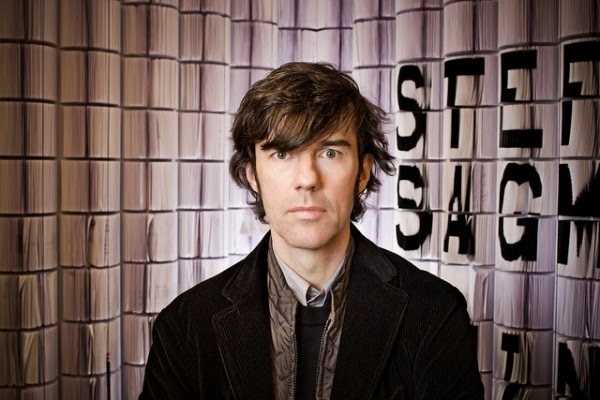Upon my research on
my previous blog regarding ‘an introduction to graphic design’, I came across
the famous name of Stefan Sagmeister. Sagmeister is one of the graphic
designers that has changed the way we look at graphic design today. He is one
of the world most confrontational artists due to his unique visual
explorations.
The fact that Stefan
Sagmeister is mentioned so often in the graphic design world left me helplessly
wondering who he is and what he has done to associate his name to such an
industry.
 |
| Lou Reed ‘set the twilight reeling’ poster, 1996 |
Born in Bregenz, Austria in 1962, Sagmeister began his career at age 15 writing for a magazine, but quickly realised that he enjoyed working on the layout more than writing articles. In “1985 he graduated from the University of Applied Arts in Vienna” (Rawsthorn, 2008) after studying graphic design which led him to further his studies in New York.
This was the start
to the peripatetic designer who is spoken of so highly. In fact I chose to
write this statement on the bases that everything I read about Sagmeister
points to the fact that he is unique, has done some orthodox things to
challenge the boundaries of the norm, as well as create inciting new ways of
thinking.
I found to be that
Sagmeisters most interesting work was produced in the late 90s where in my
opinion he began showing his true eccentricity. One poster featured a nude
Sagmeister himself with information about a lecture actually carved into his
skin, symbolising the "pain" (Zevelakis, 2012) that comes
with the production of each of his design projects.
 |
| AIGA lecture poster by stefan sagmeister, 1999. |
 |
| AIGA biennial conference – new orleans poster by stefan sagmeister, 1997 |
Sagmeister began to
specialize in CD cover designs. Designing for his musical heroes, enabled
“Sagmeister to create unique artworks based on the artist’s personas” (Heller, 2013) . What made
Sagmeister so popular was the fact that these CD covers where fresh,
entertaining and had diverse concepts. He used printing and packaging techniques
to create a visual experience unlike any other.
 |
| 'David Byrne feeling’s album cover designed by Stefan Sagmeister, 1997 |
 |
| Rolling Stones’ ‘Bridges to Babylon’ album cover design, 1977 |
In a recent
interview I watched Sagmeister explain that unfortunately the CD would be
irrelevant and so would its design. It was time for Sagmeister to reinvent his
practice. Thus was born Sagmeister’s text-based artwork, which is made up
mainly by the use of clichés and pieces of text to display poetic nuance and
ideas designed to promote individual thought.
 |
| The show revolves around the designer’s ten-year investigation of happiness (designboom, 2006) |
In the past year,
Sagmeister made a decision to collaborate with designer Jessica Walsh as his
new partner. Through his resurgence his latest works involve around the idea of
‘Design and Happiness’ and he offers visitors the experience of walking through
a creative journey in Stefan Sagmaister’s mind entitled “The Happy Show” (Sagmeister &
Walsh, 2012) . In
his exhibition he attempts to increase his “happiness via mediation, cognitive
therapy, and mood-altering pharmaceuticals.” (Sagmeister &
Walsh, 2012)
 |
| (designboom, 2006) |
 |
| (designboom, 2006) |
I am absolutely intrigued with Stefan Sagmeister’s ideas and work.
He has given meaning and value to ideas that almost seem taboo and futile. I
have significantly enjoyed his endurance and attention to detail when it comes
to bringing typography and ideas to life. I want to compliment him on his
design tenacity, its shows the passion needed to create from a place of
authenticity. I’m going to be exploring more on the themes Sagmeister presented
throughout the year, probably throughout my entire career.
Bibliography
AIGA, 2014. Stefan Sagmeister Design and Happiness. [Online] Available at: http://aigaportland.org/aiga_event/stefan-sagmeister-design-and-happiness/ [Accessed 3 October 2014].
designboom, 2006. Designboom
Interview Stefan Sagmeister. [Online] Available at: http://www.designboom.com/interviews/designboom-interview-stefan-sagmeister-2/
[Accessed 3 October 2014].
designboom, 2013. Stefan Sagmeister
The Happy Show. [Online] Available at: http://www.designboom.com/design/stefan-sagmeister-the-happy-show-at-design-exchange-dx-toronto/
[Accessed 7 October 2014].
Heller, S., 2013. Stefan Segmeister.
[Online] Available at: http://www.aiga.org/medalist-stefan-sagmeister/
[Accessed 3 October 2014].
Marksanderlin, 2009. Stefan
Sagmeister Trying To Look Good. [Online] Available at: http://designshenanigans.blogspot.com/2009/11/stefan-sagmeister-trying-to-look-good.html
[Accessed 3 October 2014].
Poggenpohl, S.H., 1993. Graphic
Design: A Career Guide and Education Directory. Illustrated ed. Michigan:
American Institute of Graphic Arts.
Sagmeister & Walsh, 2012. The
Happy Show. [Online] Available at: http://www.sagmeisterwalsh.com/work/project/the-happy-show/
[Accessed 3 October 2014].
Rawsthorn, A., 2008. What Stefan
Sagmeister has learned in his life so far§. [Online] Available at: http://www.nytimes.com/2008/02/01/arts/01iht-DESIGN4.1.9677515.html?pagewanted=1
[Accessed 3 October 2014].
Zevelakis, S., 2012. Stefan
Sagmeister trying to look good limits my life interview. [Online]
Available at: http://www.smashingmagazine.com/2012/10/03/stefan-sagmeister-trying-to-look-good-limits-my-life-interview/
[Accessed 3 October 2014].











No comments:
Post a Comment